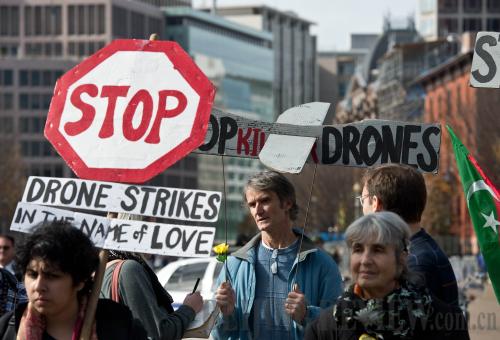|
 |
|
NO DRONES: Anti-war activists hold a rally against drone attacks in front of the White House in Washington, D.C. on November 15 ahead of the Global Drone Summit (XINHUA/AFP) |

A U.S. drone strike killed the chief of the Pakistani Taliban, Hakimullah Mehsud, on November 1. But what might be good news for Washington could surely undermine efforts by Islamabad to engage militants in peace talks. And it is undoubtedly a blow to Pakistan's Prime Minister Nawaz Sharif, who wrapped up a four-day visit to the United States on October 23, during which he asked Washington to end drone strikes. Although the death of Mehsud aroused strong protest in Pakistan, the United States continues to hold a tough stance on the matter. The drone campaign against terrorists in Pakistan is likely to top the agenda once again.
Continuous operations
During the George W. Bush administration, the United States began employing drone strikes against suspected terrorists. After Obama first took office in 2009, his administration has been making efforts to enhance this convenient antiterrorism tool.
Statistics from the Washington, D.C.-based think tank Brookings Institution shows that since 2004, the United States has used drones in 378 lethal strikes, among which 327 were operated by the Obama administration in the four and half years since he has been in the Oval Office.
For the United States, drones offer an easy method for combating terrorists.
First, the drones are efficient and can stay aloft for days on end without endangering the lives of service members. The United States has always put the lives of its citizens above all else, and highly honors the sacrifice of its service members in battle. Drones allow for a continued military presence over enemy territory without the risk of suffering casualties, effectively reducing domestic pressures regarding overseas military actions.
Currently, Predator and Reaper drones, the most frequently used, can stay aloft for more than 14 hours, four hours longer than the F-16 fighter. This allows the United States to maintain lasting pressure on terrorists. Meanwhile, drones feature rapid-strike capability. It can launch precision strikes against suspected targets in a secure area from thousands of miles away. The missiles carried by the drones can hit targets within seconds. When the U.S. intelligence system locks onto a target, therefore, a deadly strike is nearly guaranteed.
In recent years, many Al-Qaeda leaders have been killed in such strikes—the hit list includes Anwar al-Awlaki, leader of Al-Qaeda in the Arabian Peninsula, Abu-Abdallah al-Libi, a top commander of Al-Qaeda front group The Islamic State of Iraq and Syria (ISIS), and the Pakistani Taliban's first and second in command, Mehsud and Wali ur-Rehman.
What's more, drone strikes can effectively deal with the guerrilla warfare strategy of terrorists at a moderately low cost. Previously, the U.S. counterterrorism operations in Iraq and Afghanistan had been costly. Statistics show that the average per-capita expenditure of U.S. overseas military personnel is about $1 million every year. By the end of the war in Iraq and Afghanistan, the total expenditure will have reached approximately $3.7 trillion. It will be a huge burden to the United States, which is currently suffering slow economic growth as well as high unemployment.
In the meantime, the war against terrorism is an asymmetrical form of warfare, wherein terrorists are mostly hidden out of sight. Despite the larger number of U.S. combatants, their antiterrorism operations often resembled killing mosquitoes with cannons. Moreover, terrorists in Pakistan, Yemen and other places often make the most of mountainous desert terrain to wage guerrilla warfare. The drones can conduct surveillance and precision strikes with the ability to easily take off and land.
| 